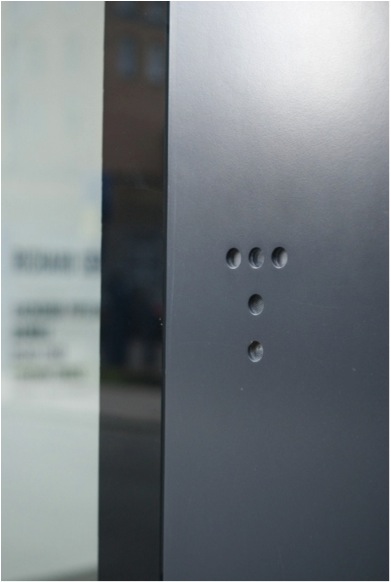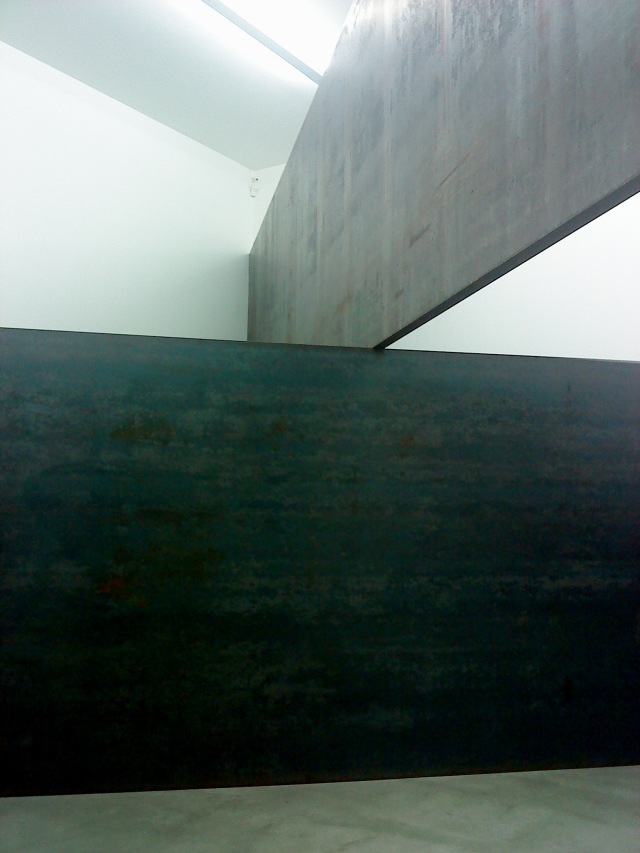A visit to Richard Serra at the Gagosian Gallery in King’s Cross with David Cook and Richard Guest.
Richard: This is a space I’ve not visited before; you told me it was big, so I was anticipating scale. And Serra’s work is big and heavy and metal and I was fully expecting lots of slabs of steel resting against each other in precarious, dangerous-looking ways. Only one work disappointed me by living up to this and that was London Cross.
Given that the siting of Serra’s work is so important, I found the entrance to the exhibition really interesting. You enter the gallery through a reception area with a desk to your left. There’s a shop/ office next to it, and straight ahead openings to two exhibition spaces. To your right a spiral staircase suggests there is a second floor (but it’s closed to the public), and beyond this lies another opening/ doorway. No work is immediately visible. It’s a curiously blank way to begin an exhibition – the lighting is cold – it filled me with a kind of sense of funereal expectation. David, you’ve seen other shows in this gallery – was the set-up similar with them or is this something specific to the Serra?
David: I have seen three shows here before – Cy Twombly, Georg Baselitz and Jenny Saville. All painters and all working to a scale directly aimed at institutional buyers (by the gallery if not by the artist). I find it a pretty cold space to be honest, but the calibre of artists cannot be ignored. I think that there are similarly huge spaces now with a bit of character and warmth, but this feels like a temple of high seriousness. Richard Serra is in many ways a perfect artist for it.
I think it is very hard not to have preconceptions about Serra’s work once you have seen a couple. It is very uncompromising and monolithic. Or monometallic. It causes spaces to be constructed around it rather than fit in to existing ones. I think that is a huge plus – it stakes a claim for art to be in the modern world, to occupy space. Art is very easily marginalised and made into decorative or bland wall covering. Serra’s work stands its ground and so tends to divide opinion.
This show consists of only four pieces. The space, as you say, is huge: but it is very amply filled by these four works. I find that simplicity very refreshing. He is not trying to spin his themes out into untold variations, but seems content to let each one speak.
Richard: I like it that the exhibition is so pared down – simplicity makes it memorable. And it functions as a showcase: each of the four works acts as a representative of a distinct strand of Serra’s work (each with its own scale). The walls are white, the floors poured, polished concrete; it looks like an art institution. All of which makes the gallery seem like a shop built for the busy buyer. You made a very interesting point when we were walking around about imagining the works in a carpeted space – it’s very difficult to see these works being owned by an individual. Who do you think would buy these works?
David: Well, someone with more than a big garden and an understanding partner. Quite a few of his big works are commissioned – and not just by plutocrats who put them in front of the offices they own to intimidate their employees. Although I think there might be a bit of that…a few of the public commissions have been controversial like Tilted Arc, because of his ‘marmitey’ quality. And that raises the question of who art in public spaces is really *for*. Does it have to be so bland that no-one dislikes it even though it means no-one actually likes it? Or is it the taste of an elite being oppressively imposed on those of us who live/work/study in these places?
Interestingly (at least according to Wikipedia) the top price for a Serra sculpture is only $1.65m (and that was back in the 1980s). So compared to some artists of lesser stature he is a bargain! But the imposing character of the work makes it difficult to live with I guess… although, interestingly, the drawings are relatively expensive. Easier to live with, obviously. But it bucks the otherwise universal trend of bigger = more expensive. Almost all art obeys this, but maybe there is a point on the size graph where the price per artistic square inch goes down?
Richard: That’s a really interesting notion – is there a maximum size beyond which an artwork becomes de trop and therefore in some way suspect? – like a balloon with a potentially dangerous volume of gas inside.
Anyway, the first room we entered contained London Cross. This for me was the least successful of the four works. It did what I expected a Richard Serra sculpture to do – it was big and flat and heavy and looked precariously balanced. What I remember talking about in this room was how the work had been installed…
David: I am fascinated by your reaction to this piece because as far as I can tell, you are disappointed because it met your expectations! For most people I think, the works they like best in any show are the ones that conform most closely to the ideal of their expectation. They come to a exhibition with a pre-imagined experience and live it out when they are going round the gallery. And I don’t exclude myself from that either. Sometimes it’s hard for a viewer to spontaneously absorb non-canon works where an artist moves away from a core style, but that is what a creative artist who is not stuck in a rut will do!
London Cross is from the core Serra style, and the room had clearly been constructed around the work – and in a lot of ways the work is more solid than the building that supports it. The cross piece hangs overhead in a vaguely threatening way, but as it is obviously well supported it is an abstract threat. Its weight, material and scale suggest it is more than simply a way of dividing space.
Perhaps our image of Serra in the UK is a bit narrow and very much shaped by the Broadgate sculpture [http://www.broadgate.co.uk/art/Fulcrum], because looking at his work as a whole the other pieces in this show are not in fact so atypical. Am I/we really so parochial?


Reblogged this on The Future Is Papier Mâché.
Reblogged this on barry comer and commented:
This is special perspective, seeing and composition. The London Cross is iconic.
[…] To read about my visit with David Cook to the recent Richard Serra exhibition at the Gagosian Gallery, click here. […]
There were 2 Serras at The Los Angeles County Museum of Art. One of them was particularly fascinating, walking in it felt like being in some kind of canyon. It also felt intimidating, the way that the steel was leaning made me nervous that perhaps it was not as secured as it should be and potentially dangerous to be near. Menacing and fascinating are probably the two words I’d use to describe both pieces.
The questions raised in the post about the purpose of public art are perpetual. Public art on private land? Public art on public land? Ultimately the person (or institution) who pays for the piece is the person who gets to keep or must remove what was installed, like any commission. Stuff on this scale ends up being almost as controversial as architecture, and probably is a kind of miniature, odd architecture. And comes with an appropriate price tag. It is by its size a tangible expression of power, and whoever can afford to buy and put it up is demonstrating power. So the responses to it will likely be appropriate depending on whether the viewer is powerful or not, or whether they are drawn to power or not…
That’s very interesting …thanks for the comment. It seems to link Serra with our previous gallery visit which was to Anselm Kiefer (over on The Future is Papier Maché – https://londoneyeball.wordpress.com/2015/02/01/anselm-kiefer-a-conversation-part-one/). Both of them have an ambiguous relationship with power – both drawn to it and uncomfortable with it.
It’s clear that now that I have gotten off of the awful
monster that is Zuckerberg’s (much of my art community unfortunately seems to be stuck there, although we all met in other places), I very much need to be paying attention to your blog – and I am going to make good on that! I’m not very familiar with Kiefer, now I’ll take a closer look and remember the conversation you recorded on your post mentioned above. So glad to have rediscovered you here!
[…] Concluding part of a visit to Richard Serra at the Gagosian Gallery in King’s Cross with David Cook and Richard Guest. (continued from here) […]
[…] To read about my visit with David Cook to the recent Richard Serra exhibition at the Gagosian Gallery, click here. […]
[…] To read about my visit with David Cook to the recent Richard Serra exhibition at the Gagosian Gallery, click here. […]
[…] To read about my visit with David Cook to the recent Richard Serra exhibition at the Gagosian Gallery, click here. […]
[…] To read about my visit with David Cook to the recent Richard Serra exhibition at the Gagosian Gallery, click here. […]
[…] To read about my visit with David Cook to the recent Richard Serra exhibition at the Gagosian Gallery, click here. […]
When I am in the middle of or under the influence of a piece created by Richard Serra my mind and body reacts in a certain way, That feeling and those thoughts going on in my head – that is what a Serra is all about for me.
[…] To read about my visit with David Cook to the recent Richard Serra exhibition at the Gagosian Gallery, click here. […]
[…] To read about my visit with David Cook to the recent Richard Serra exhibition at the Gagosian Gallery, click here. […]
[…] To read about my visit with David Cook to the recent Richard Serra exhibition at the Gagosian Gallery, click here. […]
[…] To read about my visit with David Cook to the recent Richard Serra exhibition at the Gagosian Gallery, click here. […]
[…] To read about my visit with David Cook to the recent Richard Serra exhibition at the Gagosian Gallery, click here. […]
[…] In the meantime, Ashley Lily Scarlett and I have started a new blog together. It’s a conversation in pictures and it’s called Between Scarlett and Guest. And to read about my visit with David Cook to the recent Richard Serra exhibition at the Gagosian Gallery, click here. […]
[…] You can read an email conversation we had about a previous trip to the RA here: Anselm Kiefer. It’s in three parts. Two is here. And three is here. To read about our visit to the recent Richard Serra exhibition at the Gagosian Gallery, click here. […]
I find the monumental power of Serra’s work really exciting, and love the brutal materiality and scale. Framing the works with a description of the entrance to the gallery with its reception and gift shop seems to me marvelously divisive given that site-specificity is so crucial – I can almost imagine a National Trust tea shop selling commemorative tea towels on the way out – Brilliant!